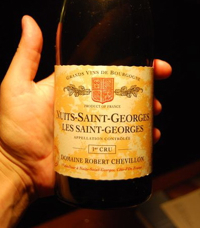|
Pinot Noir Wine
Yet, despite the passions that Pinot Noir wine can induce, it is not lacking in controversy. While some praise and revel in its subtlety, nuance and finesse, others find many examples lacking oomphf, weight and power. While we personally couldn't disagree more, as even lighter-bodied wines can have great penetrating intensity to their flavors, some people prefer grape varieties that have more darkness and body. Pinot Noir does not generally have as dark a color or as much tannin as some grapes like Cabernet Sauvignon or Syrah. However, it in no way lacks for flavor, depth and complexity. And it is capable of producing amazing wines that vary from light and ethereal in body to intense and penetrating. For all these reasons, truly understanding Pinot Noir can be tricky. It is capable of such subtlety and yet such dramatic variability that it can take a lifetime to study and fully appreciate all the facets of this amazing grape. Where Is Pinot Noir Wine Made?For many wine lovers, Pinot Noir is Burgundy. All red Burgundy from the Cote d'Or, with only a few notable exceptions, are 100% Pinot Noir. This is where the grape originated and is still considered its home. Pinot Noir is a perfect match for the terroir of Burgundy. The grape is notoriously tricky to grow and can be quite finicky. Yet, when ripened slowly on the cool slopes of the Cote d'Or, the greatest wines in the world result. Many people would argue that there is no better Pinot Noir wine on the planet than the best from Burgundy.However, Pinot Noir, like many other grape varieties, has migrated around the world and examples can be found from many different wine growing regions. Most notably, California and Oregon have extensive plantings of Pinot Noir and make many outstanding wines. While some of the regions in California are too hot to make good Pinot Noir, resulting in over-ripe, almost syrupy wines, the cooler areas have had increasing success with the grape. For example, regions like the Central Coast and the Russian River Valley in California and parts of Oregon, which see cooler weathers and cooling fog, more closely mimic the weather in Burgundy. What Styles of Wine Does Pinot Noir Produce and What Do They Taste Like?Pinning down Pinot Noir can be tricky to say the least. On a basic level, practically all wine produced from Pinot Noir is dry red wine. One exception is in Champagne where the grape is used extensively, along with Chardonnay and Pinot Meunier to produce white and rosé sparkling wines. However, in most Burgundy, Californian, Oregon and other examples, Pinot Noir is a dry red wine.Pinot Noir wine tends to be lighter in body and color than Cabernet Sauvignon, Merlot, Syrah and other full bodied varieties. It is generally lower in tannin. However, it is not lacking in structure as the acid level of Pinot Noir is generally greater than these other grapes. Therefore, it tends to produce wines that are somewhat lighter in body and brighter. However, this is a gross over-simplification. Wines produced in warmer climates like California can be quite dark and rich. Likewise, even in Burgundy the wines can vary from light and airy to dark and powerful. The wines tend to lean toward the red fruit end of the spectrum and can often have pronounced floral qualities, such as seductive rose petals. However, particularly as the wines age, they can have a perfumed complexity that includes darker nuances, earth, minerals, mushrooms, truffles and meat. In Burgundy, the home of Pinot Noir, terroir is king. The specific vineyard a wine comes from is considered of paramount importance, instilling much more character and complexity than the Pinot Noir grape itself. The grape is seen as just a vehicle to get the soil's soul into your glass. Most wines are named for the vineyard or village that the grapes came from, you won't find Pinot Noir anywhere on the label. After all, all of them are 100% Pinot Noir, so the difference from one bottle to the next is all in the soil and the producer. From these varied soils can come a huge variety of styles. While some regions produce fine, delicate, perfumed wines of great subtlety and finesse, others produce darker, meatier wines with power and a sappy, dense feel to them. Winemaking style also obviously plays a role. More "modern" growers often produce riper wines with more forward fruit flavors and oak influences while the traditionalists let the soil speak freely, without "doctoring" the wine too much. The wines of Burgundy, despite being generally lighter in body than some other wines, can age a very long time. Those with balance and a powerful acid and mineral structure can require decades to reach their peak. While some wines are made to drink young, many benefit from or even demand very long aging. As another gross over-generalization, most wines produced in warmer New World regions like California and Oregon tend to make riper, darker wines. They will still be lighter in color and body than a California Cabernet Sauvignon, however. These wines tend to be more forward, showing more sweet fruit early on with lower acid levels. While some wine lovers adore their juicy and sexy personality, others prefer the firmness, balance and verve of their Burgundian counterparts. In reality, you can't directly compare California or Oregon Pinot Noir wines with Burgundy. Even though they come from the same grape, they are apples and oranges. The terroir is too different. They produce different wines. Return to the Grape Varieties section.  |



 We make no apologies that Pinot Noir wine quite possibly represents our favorite wines on the planet. This noble grape variety is capable of such subtlety, nuance, complexity and grace that it is hard to deny its greatness. It is also one of the most transparent grapes, showing great variability depending on the location it is grown. One is a flowery, pretty seductive wine, the next is meaty and earthy. Pinot Noir wines are full of contradiction. Yet the best are capable of reaching the greatest heights of winedom.
We make no apologies that Pinot Noir wine quite possibly represents our favorite wines on the planet. This noble grape variety is capable of such subtlety, nuance, complexity and grace that it is hard to deny its greatness. It is also one of the most transparent grapes, showing great variability depending on the location it is grown. One is a flowery, pretty seductive wine, the next is meaty and earthy. Pinot Noir wines are full of contradiction. Yet the best are capable of reaching the greatest heights of winedom.


